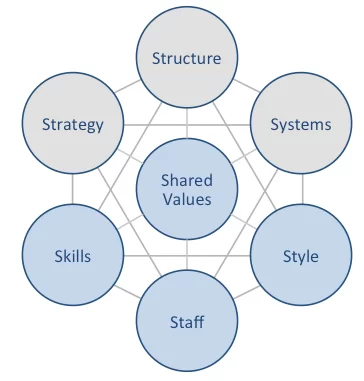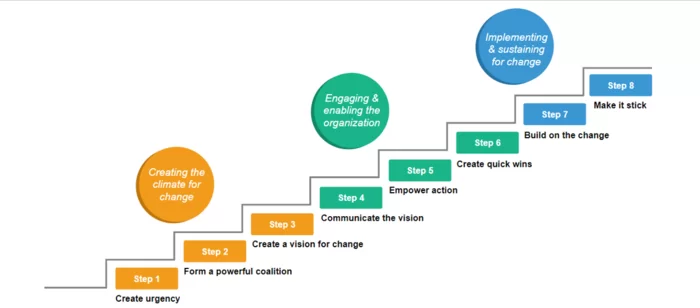Simplifying the Change process
What is the Change Management Process?
An organization goes through change due to many reasons such as technological implementation, compliance initiatives, improvements in customer service, etc. Change is the door that opens your organization to new opportunities for growth, expansion, and sustainability. During a period of change, each employee in every team of the company goes through a transition. For making the transition smooth, a proper change management plan needs to be in place. For project managers, there are several tips, models to be followed to implement change management successfully.
Change Management Models
Although there are many change management models, three of them are popular among top companies.
Organizations mostly implement one of the three models given below.

Lewin's Change management model
Kurt Lewin invented this model in the 1950s. The model is easy to use. Thus, it is widely popular among companies. However, it takes time to implement. The model defines three stages of change. The three stages are:
Unfreeze
The period of unfreezing aims to eliminate fear and resistance to change. Any new policy or technology will face some resistance initially. The objective is to motivate them to accept change.
Transition
After initiating change, the organization remains in the transition period. It lasts for some time, depending on the kind of change. For successfully crossing this stage, able leadership is necessary.
Refreeze
After the period of change, the staff gets accustomed to new guidelines. The company gains stability again. This final stage is called refreezing.

McKinsey 7-S model
The model is a result of the collaborative efforts of Robert Waterman, Tom Peters, Richard Pascale, and Anthony Athos. It was created in 1978. The model specifies 7seven factors that act as agents of change. The factors are – shared values, strategy structure, systems, style, staff, and skills. Although it is a complex model, some companies adopt it as it combines rational and emotional components.
'Kotter's 8-step change model
The creator of this model is John Kotter, who was a Harvard University professor. The model emphasizes on preparing the employees to welcome change. It is easy to implement – it is adopted stepwise. It has eight different steps that describe the process of accepting and getting accustomed to change. Change is difficult to manage and implement. The model makes the transition a straightforward process.

The steps in change management
The following steps are a basic blueprint that can guide managers through the change.
Each change is different and comes with different challenges. Managers with adequate leadership skills can tackle these challenges with cooperation from their teams.
Step 1 – The Objective
Establish clarity on your vision for the company. What is the purpose of implementing the change? Make your team(s) aware of where you are and where you want to be. How are you planning to build a bridge between both? When teams are clear on this, you will have their support in your company's transition.
Step 2 – Sell the need for a change
Have a two-way communication with your team. Know where they stand on the subject. It is not enough if you want to implement something new. You need your employees to be on board. Ask for input from all parties involved in the process.
Step 3 – Appoint champions for change
Your change management leadership team will need influential employees who can through the transition process. Find and choose the right people to be a part of your team. Build a powerful team as you will be in full control of implementing the new guidelines.
Step 4 – Communicate your vision
Your vision should reflect the greatness of your change. If the change is significant enough, it can drive you to modify your 'company's vision and mission as well! To eliminate opposition, communicate your vision to the entire organization.
Step 5 – Identify and remove stumbling blocks
Change is expensive for the organization in more ways than one. You may have to modify the structure of your organization for a smooth transition. Your staff needs to be trained in new skills. You may have to reset your goals and invest in new tools and methods to accommodate the change.
Step 6 – Set realistic goals
Milestones are necessary to track your progress. In the end, when you see how far you have come, it is satisfying to pat yourself on your back. However, the milestones you set for your team have to be realistic and achievable
Step 7 – Aim for quick wins in the early period
Failure in the initial stages of transition quickly demotivates everyone. It may encourage naysayers to oppose the change even more strongly. Thus, it is wise to aim for quick wins during the nascent stage.
Step 8 – Keep an eye on the implementation
Reaching the implementation is indeed a milestone, but a good part of the journey is still left. Stay extra vigilant during the initial stages of implementation. Scan the process for unforeseen changes or negative impacts.
Step 9 – Incorporate the changes in your 'company's culture
While implementing new guidelines, your company's culture also changes. Focus on continuous improvement and ways to incorporate changes in your office culture to complement the transition you have made.
Common challenges in change management
The concept of organizational change is continuously evolving. One of the major challenges in change management is navigating the human element. People are inherently resistant to change. They do not easily step out of their comfort zone to experiment with something that they are not familiar with.
Adjusting to change does not come naturally to many people. Add to this the fact that transitioning itself is a cumbersome process. The solution requires involving people from the first stage of change. Keep them informed about plans. Also, consider inputs from all the people who will be affected by the change. It can make it less daunting for them.
Supporting tools and components for implementing the change management process
Appropriate tools and components developed either by the change management team or by the group of stakeholders are essential for the change management process to be effective. The following are some of the tools and activities for implementing a change management process.
- Business care
- A plan for continuous improvement
- Resistance management
- Product/business roadmaps
- Activities to assess readiness
- Tutorials/sessions to train the staff in additional skills
- Building a platform for stakeholder feedback
- Measurements and analysis
Numerous models have proven to be beneficial for managing change. Some models focus on the individual transition, while some other models look at the whole organization as a single entity that is changing. You can not pick one 'right' model. You need to research the different models and adopt one that is suitable for the size and type of your organization.
Why does change fail?
Some organizations fail to adapt to change. Several obstacles stand in the way of change. What are they and how to avoid them?
Not preparing for change
Inadequate preparation is a common barrier to change. Implementing change is an expensive process. It consumes various resources – time, money, and human effort. Planning for change involves discussing the answers for questions like – Who are the employees who will be affected by the change? What kind of additional training do they need? What is the training schedule? How much will it cost? Will the training affect the ' 'employee's workflow and productivity?
Lack of flexibility in organizational strategy
When new forces of change emerge, it often calls for changes in strategy, vision, and mission. If the leaders of the organization are reluctant to modify the organizational structure to accommodate the change, they should be willing to plan thoughtfully. They also need to introduce just the right amount of flexibility, so they can bend without breaking.
Disregarding employee input
Not taking inputs from employees who will be affected by the change is yet another reason for failure. If they feel left out of the process, there is a higher possibility that you will face opposition from them. It makes them feel excluded. If employees are well aware of the purpose and necessity of change, there are more likely to contribute and participate actively in it. Employee support is a huge factor in whether or not you implement change successfully.
Lack of effective communication from the leaders
During the transition period, employees expect transparency from the change management team. Maintaining transparency requires effective communication from the leaders. Although it is an inherent trait of a leader, it is more important during times of change. An opaque leadership will block out employees from the process. Exclusion leads to resistance, which eventually fails. Thus, inadequate communication is a major reason for a failed change management process.
Looking at change as a threat
One needs to have a positive outlook on change. However, if employees are not clear about the need for the proposed change or how they can benefit from it, they will perceive change as a threat rather than an opportunity for betterment. It creates undue stress on employees. Their workflow and productivity decrease. The consequence of this is again, resistance to change. Train your employees well to perceive change as an opportunity and welcome it.
An overzealous leadership
When the performance drops, leaders have an urge to implement change just for the sake of boosting performance. They do not pay heed to what kind of change is needed or whether any change is required. This attitude can also lead to failure. As a leader, you should focus on whether critical processes require a change.
A few powerful tips for successful change management.
-
Define clearly the metrics for success
Everyone can be motivated to work towards change if they are aware of the exact metrics that measure success. Define milestones in your journey so that the team can have small celebrations along the way. The whole team should visualize the same goal and collaborate to work towards achieving it.
-
Celebration of early wins
Set manageable goals in the beginning. It can help you win early on. These small wins are success stories that motivate the team to work towards embracing change. Capture every small win. Communicate it to all the members involved.
-
Sustenance of dialogue
Dialogue is the key to achieve compliance from employees. At every stage of the change implementation, the leaders need to keep the dialogue going. The end of each stage should involve retrospection to determine the successes and failures.
-
Focus on managers
Managers are the bridge between employees and the change management team. However, there is less focus on the development of the manager's skills. It can make or break a change management process. Each manager should be provided with the necessary tools and knowledge to understand what the changes are and why they should be implemented.
-
Measures to handle resistance
Any change will first be met with resistance. Human beings are generally resistant to change. They are reluctant to move out of their comfort zone. Make sure that your employees' struggle with change is time-bound. Expect some resistance initially and decide how to plan to deal with it. Provide a platform for stakeholders to communicate their concerns, perceived threats, and discuss the change.
Four great examples of change management in the history of business
Discussed below are the case studies of some companies that successfully implemented change. Their stories give insights into best practices regarding change management. Many organizations have achieved this, but these companies are outstanding examples.

Qatar is the world's richest economy per capita. In 2005, the chairman and CEO of Qatar's state-owned telecom company Qtel together started a wild acquisition spree. In 7 years, they managed to own 17 telecom operators in the Muslim world.
In a major shift of strategy in 2012, Qtel decided to grow through integration rather than by acquisition. All their diverse telecom brands merged to form a single entity – Ooredoo.
The job of popularising this new brand was handed over to a change management team. They identified what their brand stood for. They marketed Ooredoo as a brand that stood for greater communication freedom in the Muslim world and gave a voice to women and rural communities.
In February 2013, Ooredoo launched with Lionel Messi as the global ambassador. It was a huge success. Today, Ooredoo is a leading international brand in the telecom industry.

In 2004, ' 'Shell's share prices hit rock bottom due to an oil reserve crisis. Then the chairman of the group, Sir Philip Watts, quit abruptly. The man who took over, Jeroen van der veer, believed that a complete transformation was required to survive the crisis. They followed a standardized process for all branches across the group. Implementation of these changes would result in some countries losing their market share. It was a loss in the short term.

After the financial crisis of 2008, European Union regulators ordered the RBS group to sell its insurance business if they wanted to avail £45 Bn state aid. At that time, the insurance business was led by Paul Geddes. He took up the responsibility of separating the insurance business from the RBS group and establishing a stand-alone company.
Persistence and positive approach towards a disruption helped Paul Geddes establish a stand-alone insurance company Direct Link Group. The separation journey lasted 18 months. In this case, the team did not have a plan B. They inspired everyone to have a shared sense of controlled urgency so that they were on track. The implementation as a success. Geddes succeeded in establishing a viable stand-alone company.

In 2008, Santander decided to make a mark in the UK banking sector. The proposed strategy was the acquisition of heritage-centric financial institutions in the UK. However, bringing people from different institutions together would be a Herculean task. Also, expecting people to let go of their old ways and embrace the changes in the banking sector would be challenging.
All stakeholders were brought together and informed about the change. They implemented two-way communication to understand perceived threats and risks. The action was taken to mitigate risks. Careful management resulted in successful integration.
Santander finally launched in 2010. In a short duration of three years, it went on to become one of the leading retail banks in the UK.